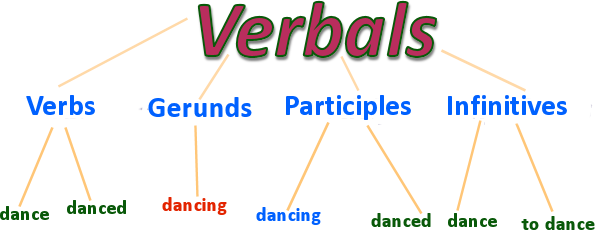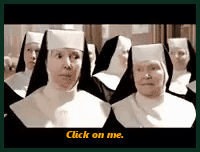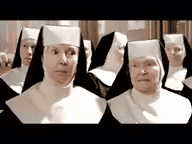Verbs, Gerunds, Participles & Infinitives


Sister Ruth, my first grade teacher, taught us that verbs were
“action words”. It made sense then and it makes sense now though
she may have over-simplified for our benefit. In fact, verbs are
not always action words. Some verbs can be dynamic (action verbs)
but others are static (non-action verbs). Moreover, verbs are only
one type of action word. There are others. Look at the sentences
below and see if you can identify the other types of action words.
- Eleazar said that dancing with Susan is fun.
- Maria Jose said that she is the real Dancing Queen.
- Dancing alone, the woman mourned the loss of her dead husband.
- Dance or I will shoot your feet off!
- The gunslinger cowboy told Vladimir to dance.
Well, all the sentences use the word dance in one way or another,
right? But are those all verbs? Are any of them verbs? Hmmm.
Let’s take a look at the image below to figure this out.

Clearly, dance is the base form of the verb and danced is the past
tense form of the same verb. But what about dancing and to dance?
And why are there two occasions of dance and two occasions of danced?
As you can see, dancing is a gerund
and dancing is a present participle.
■In example number 1 above dancing is a gerund. Why? It is because
here dancing is used as a noun. A person could say, “Disneyland is fun”,
“English is fun” or “parties are fun”, right? All, like dancing here,
function as nouns.
■However, in example 2 above dancing, a present participle,
is used as an adjective. It describes, as would any adjective, the noun, Queen.
We could easily say “beautiful queen”, “intelligent queen” or “lazy queen”.
Dancing here works the same way as beautiful, intelligent or lazy.
All describe the noun Queen.
■Number 3 above might seem a little
tricky but think about this question: Which woman mourned the loss
of her husband? Was it the old woman? Was it the rich woman? No.
It was the woman who was dancing, that is, the dancing woman.
So, we have a present participle used as an adjective here.
 Picking
Picking oranges in the backyard is easy.
 Picking
Picking oranges in the backyard, Len smiled broadly.
Summary:
Dancing is called a gerund
and functions as a noun.
Dancing is called a
present participle and functions as an adjective.

Check-Up
Indicate if the verbals ending in -ing are
used as nouns or adjectives.
1) Singing in the rain can be a joyful experience.
2) Singing in the rain, the natives celebrated the end of the drought.
3) The crying baby annoyed the others in the restaurant.
4) Smoking on the UCLA campus is strictly forbidden.
5) Dancing through the snow, Rudolf carried Santa Claus to my house.
6) Using her cellphone to check
vocabulary, she cheated on the test.
As for the two instances of danced, one is the verb dance in the
past tense while the other is a past participle. Present participles
end in –ing. With regular verbs past participles end in –ed. Note
that the past participle is used with the perfective aspect.
For example: "Fabiana has danced with an Uber driver."
Here are more examples.
1. Len has danced in Roppongi before. (Present Perfect)
2. Diogo had left the school before Tatiane did. (Past Perfect)
3. Eleazar will have eaten all the food before Susan returns home. (Future Perfect)
On the other hand, the continuous aspect is expressed by the present participle.
1. Haruhisa is eating Ester’s lunch. (Present Continuous)
2. Ester was drinking Haruhisa’s water yesterday. (Past Continuous)
3. Eleazar will be dancing with Susan soon. (Future Continuous)
 Let’s look now at the last type of verbal, the infinitive. There are two forms.
The first is the same as the base form of the verb and is called
a bare infinitive because there is no infinitive marker “to”.
The second form is the complete infinitive with the marker “to” used
to introduce it. Please do not confuse the infinitive marker “to”
with the preposition “to”. Compare the two words in the following sentence:
Let’s look now at the last type of verbal, the infinitive. There are two forms.
The first is the same as the base form of the verb and is called
a bare infinitive because there is no infinitive marker “to”.
The second form is the complete infinitive with the marker “to” used
to introduce it. Please do not confuse the infinitive marker “to”
with the preposition “to”. Compare the two words in the following sentence:
Maria Jose went to the club to dance the night away.
“To the club” is a prepositional phrase, but “to dance” is an infinitive.
In fact, “to dance the night away” is an infinitive phrase.
Now, let’s prove that both dance and to dance are different forms
of the same infinitive. Consider the following sentences in direct
and reported speech.
John Wayne: “Dance, cowboy!”
This is direct speech. We use the bare infinitive in the imperative mood.
Ester: John Wayne told the cowboy to dance. This is reported speech.
English grammar requires that an imperative be reported using a complete infinitive.
Here are a couple more examples.
1. Police: “Put your hands up!”
Abby: The police ordered Eleazar to put his hands up.
2. Mom: “Wash your hands before you come to the table.”
Aki: Your mom told you to wash your hands before you come to the table.
Finally, look at the example sentences 4 and 5 above. Number four uses the bare infinitive in direct speech while number 5 reports using the complete infinitive.
Clear? If so, Sister Ruth would be so proud of you.
However, we might need a little practice, so here goes.
Final Exam
Identify the high-lighted verbal in each sentence below.
1) Getting enough money for the project will not be easy.
2) To err is human, to forgive is divine.
3) The president has lied to us again.
4) We had a stimulating discussion about
international marriage.

Home




 Check-Up
Check-Up
 Let’s look now at the last type of verbal, the infinitive. There are two forms.
The first is the same as the base form of the verb and is called
a bare infinitive because there is no infinitive marker “to”.
The second form is the complete infinitive with the marker “to” used
to introduce it. Please do not confuse the infinitive marker “to”
with the preposition “to”. Compare the two words in the following sentence:
Let’s look now at the last type of verbal, the infinitive. There are two forms.
The first is the same as the base form of the verb and is called
a bare infinitive because there is no infinitive marker “to”.
The second form is the complete infinitive with the marker “to” used
to introduce it. Please do not confuse the infinitive marker “to”
with the preposition “to”. Compare the two words in the following sentence:


